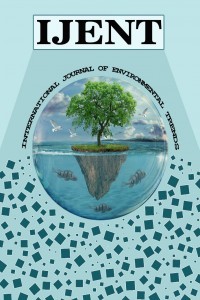EVALUATING CLIMATE VARIABILITY FROM RAINFALL AND TEMPERATURE: INSIGHT FROM NIAMEY AND MARADI IN NIGER
EVALUATING CLIMATE VARIABILITY FROM RAINFALL AND TEMPERATURE: INSIGHT FROM NIAMEY AND MARADI IN NIGER
Niger is a landlocked West African country located between parallels 11° 37 and 23° 33 Northern latitudes, meridians 16 °East longitudes and 0 °10 West longitude. The country covers 1,267,000 kilometers square and is divided into eight main regions; Agadez, Diffa, Dosso, Maradi, Tahoua, Zinder, Tillabery, and Niamey. From a climate point of view, the country has three different zones; Northern Saharan arid zone with total annual rainfall average of 20-75 mm, Saharan-tropical zone 75-160 mm and the Sahelian zone with 250-800 mm. Therefore, the rainfall patterns vary from one region to another and within the same region. This article analyzed regional climate variability in the regions of Niamey and Maradi during 1979-2013s. To do this, intra-regional and inter-regional variability of monthly temperature, total annual rainfall, monthly solar radiation, monthly wind speed, and monthly relative humidity have been evaluated by Buishand’s Test in the series analysis. The findings a time lag in climate variability among these two regions; all climate variables’ variability firstly occurs in Niamey and then Maradi except for wind speed and solar radiation. Accordingly, the region of Niamey is more fragile than the region of Maradi. Lastly, Niger faces climate variability which could compromise its rural small-scale farmers’ rainfed agriculture and livestock’s activities.
Keywords:
Climate variability, Maradi, Niamey,
___
- References[1] A. Ben Mohamed, Van Duivenbooden and Abdoussallam, S., 2002. Impact of climate change on agricultural production in the Sahel – part 1. Methodological approach and case study for millet in Niger, Journal of Climatic Change 54(3):327-348 DOI: 10.1023/A:1016189605188, https://core.ac.uk/download/pdf/12108148.pdf[2] Seidou, A., Berbet, M., Bruneau and Bobee, B., 2006. Parametric Bayesian combination of local and regional information in flood frequency analysis, Water Resources Research, Vol. 42, W11408, doi:10.1029/2005WR004397. https://doi.org/10.1029/2005WR004397[3] IPCC, 2007. Climate Change 2007. Synthesis Report. Contribution of Working Groups I, II & III to the Fourth Assessment Report of the Intergovernmental Panel on Climate Change. Geneva[4] Clover, 2010. Food Security in Sub-Saharan Africa. Afr.Food Rev. 12(1), 5-15. http:/dx.doi.org/10.1080/10246029.2003.9627566[5] Verpoorten, M., Arora, A., Stoop, N., Swinnen, J., 2013. Self-reported food insecurity in Africa during the food price crisis. Food Policy 39, 51–63. http://dx.doi.org/10.1016/j.foodpol.2012.12.006.[6] Epule, T., James D. Ford, Shuaiblwasa, Laurent Lepage (2017). Climate change adaptation in the Sahel. Environmental Science and Policy 75 (2017) 121-137. The journal of peasant Studies, 2018. Vol.45, No 1, 89-107, publishing. https://doi.org/10.1080/03066150.2017.13112355[7] UNREDD, UNREDD, 2015. Executive Summary: 2015 Annual Report of the UN-REDD Programme Fund. Available online at: http://www.unredd.net/documents.html?view=browse&customtags=172&startdate=&enddate=&dmlang [8] African Climate Change Fund, 2016. Supporting African Countries to Access International Climate Finance: Enabling a Transition Towards Climate Resilient, Low-CarbonDevelopment. The African Development Bank Available online at: https://www.afdb.org/fileadmin/uploads/afdb/Documents/Project-and-Operations/Africa_Climate_Change_Fund_-_Supporting_Africa_countries_to_access_international_climate_finance.[9] Alvaro Calzadilla, Tingjuzhu, KatrinRehdanz, Richard S.J Tol, Claudia ringer (2013). Economywide impacts of climate change on agriculture in Sub-Saharan Africa. Ecological Economics 93 (2013) 150-165. [10] Gianni, A. Giannini, Michela Biasutti , Michel M. Verstraete (2009). A climate model-based review of drought in the Sahel: Desertification, the re-greening and climate change. Global and Planetary Change 64 (2008) 119–128[11] Giannini, A., S Salack, Lodoun, A Ali, A T Gaye and O Ndiaye (2013). A unifying view of climate change in the Sahel linking intra-seasonal, interannual and longer time scales. Environ. Res. Lett. 8 (2013) 024010 (8pp) doi:10.1088/1748-9326/8/2/024010[12] Reynoulds, Julie Snorek, Linda Moser, Fabrice G. Renaud (2017). The production of contested landscapes: Enclosing the pastoral commons in Niger. Journal of Rural Studies 51 (2017) 125-140.[13] Lu and Delworth M. Held, T. L. Delworth, J. Lu, K. L. Findell, and T. R. Knutson (2005). Simulation of Sahel drought in the 20th and 21st centuries. www.pnas.org cgi doi 10.1073 pnas.0511236103 [14] Mertz, Ole, Christen Halsnaes, Jorgen E. Olesen and Kjeld Rasmussen (2009). Adaptation to Climate Change in Developing Countries.
- [15] IPCC (2011). Special Report on Renewable Energy Sources and Climate Change Mitigation 24th September 2011, The New School for Social Research, New York [16] MOUSSA NA ABOU Mamouda (2010). Climate change adaptation and food insecurity in Maradi district – Niger. Icid+18, August 16-20, 2010, fortaleza - ceará, Brazil. D international conference: climate, sustainability and development in semi-arid regions[17] Alhassane Ali et al., 2010 Seydou B. Traore n, Abdou Ali, Seydou H. Tinni, MamadouSamake, IssaGarba, Issoufou Maigari, AgaliAlhassane, Abdallah Samba, Maty Ba Diao, Sanoussi Atta, Pape OumarDieye, Hassan B. Nacro, Kouamé G.M. Bouafou (2010). AGRHYMET: A drought monitoring and capacity building center in the West Africa Region. Weather and Climate Extremes 3 (2014) 22–30. http://dx.doi.org/10.1016/j.wace.2014.03.008
- ISSN: 2602-4160
- Başlangıç: 2017
- Yayıncı: Muhammed Kamil ÖDEN
Sayıdaki Diğer Makaleler
GEODESIGN FOR URBAN PLANNING – THE EXAMPALE OF HARRAN UNIVERSITY'S CAMPUS MASTERPLAN
Fred Ernst, Saffet Erdoğan, Mehmet Yılmaz, Mustafa Ulukavak, Halil İbrahim ŞENOL, Abdulkadir MEMDUHOĞLU, Mehmet Ali ÇULLU
COLOR DIFFERENTIATION OF WALL STONES: HISTORIC KARATAY COLLEGE BUILDING
REGRESSION MODELS BY GRETL AND R STATISTICAL PACKAGES FOR DATA ANALYSIS IN MARINE GEOLOGY
Makbule Nisa MENCET YELBOGA, Abdoul-aziz Hamidou TAFFA, Cengiz SAYİN
A REVIEW ON URBANIZATION, POLLUTION AND BIODIVERSITY IN İZMİR
Ece SÖKMEN YILMAZ, Semih YILMAZ
